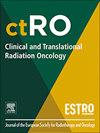Regular aerobic exercise ameliorates radiation-induced pulmonary fibrosis: An animal study
IF 2.7
3区 医学
Q3 ONCOLOGY
引用次数: 0
Abstract
Background and purpose
A definitive treatment for radiation-induced pulmonary fibrosis (RIPF), a common side effect of radiation therapy for thoracic cancer, remains to be established. Pulmonary rehabilitation programs, including regular aerobic exercise, may ameliorate RIPF. However, a scientific basis supporting the protective effect of exercise against RIPF is lacking.
Methods
Seven-week-old Sprague-Dawley rats were randomly allocated to the control (CON), training without irradiation (T), irradiation only (IR), and irradiation with training (IR + T) groups. Irradiation of the right lung was commenced at 40 Gy over five consecutive days, followed by regular aerobic exercise training using a treadmill for 7 weeks. The variables were assessed before and after irradiation. Pulmonary fibrosis was assessed using Masson’s trichrome (MT) staining and hydroxyproline (HYP) assay. Behavioral tests were conducted to evaluate functional changes. In addition, potential molecular mechanisms were explored.
Results
The body weights of the rats in the IR and IR + T groups were lower than those in the other two groups. The Rota-rod test revealed significantly higher exercise capacity in the IR + T group compared to that in the IR group, which was closer to that in the CON group. MT staining and HYP assay revealed that the amount of fibrosis in the IR + T group was significantly lower than that in the IR group (collagen area (%): IR, 28.00 ± 7.51, n = 7; IR + T, 24.03 ± 6.93, n = 9; HYP concentration (μg/mg): IR, 0.80 ± 0.09, n = 7; IR + T, 0.47 ± 0.14, n = 9; p < 0.05). Superoxide dismutase activity in the IR + T group was higher than that in the IR group (IR, 84.02 ± 12.56, n = 7; IR + T, 100.55 ± 11.18, n = 9; p < 0.05).
Conclusions
Regular aerobic exercise ameliorated RIPF in rats, suggesting its potential utility in pulmonary rehabilitation programs for patients undergoing thoracic radiation therapy.
有规律的有氧运动改善放射性肺纤维化:一项动物研究
背景与目的放射性肺纤维化(RIPF)是胸部肿瘤放射治疗的常见副作用,目前尚无明确的治疗方法。肺康复计划,包括定期有氧运动,可以改善RIPF。然而,缺乏支持运动对RIPF的保护作用的科学依据。方法将7周龄Sprague-Dawley大鼠随机分为对照组(CON)、无照射训练组(T)、仅照射组(IR)和训练照射组(IR + T)。连续5天对右肺进行40 Gy的照射,随后在跑步机上进行7周的常规有氧运动训练。在辐照前后对变量进行评估。采用马松三色(MT)染色和羟脯氨酸(HYP)法评估肺纤维化。进行行为测试以评估功能变化。此外,还探讨了潜在的分子机制。结果IR组和IR + T组大鼠体重均低于其他两组。Rota-rod测试显示,IR + T组的运动能力明显高于IR组,与CON组接近。MT染色和HYP分析显示,IR + T组纤维化量明显低于IR组(胶原面积(%):IR, 28.00±7.51,n = 7;IR + T, 24.03±6.93,n = 9;忧郁浓度(μg / mg):红外光谱、0.80±0.09,n = 7;IR + T, 0.47±0.14,n = 9;p & lt;0.05)。IR + T组超氧化物歧化酶活性高于IR组(IR, 84.02±12.56,n = 7;IR + T, 100.55±11.18,n = 9;p & lt;0.05)。结论:定期有氧运动可改善大鼠的RIPF,提示其在胸部放射治疗患者肺康复计划中的潜在应用。
本文章由计算机程序翻译,如有差异,请以英文原文为准。
求助全文
约1分钟内获得全文
求助全文
来源期刊

Clinical and Translational Radiation Oncology
Medicine-Radiology, Nuclear Medicine and Imaging
CiteScore
5.30
自引率
3.20%
发文量
114
审稿时长
40 days
 求助内容:
求助内容: 应助结果提醒方式:
应助结果提醒方式:


